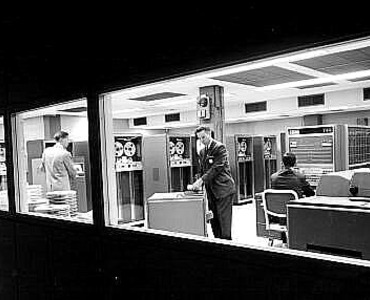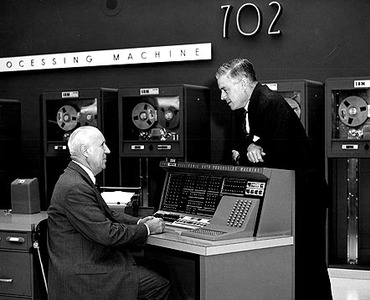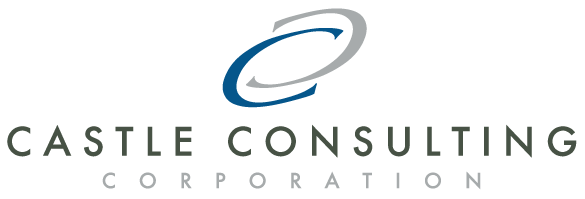How do you change the way your organization manages knowledge, while keeping your smartest and most conscientious people on board?
 In my last blog I wrote about an organization’s “knowledge market,” and how if we view knowledge as currency we can see different employees taking on market roles. I introduced the roles of knowledge miners, knowledge brokers, knowledge entrepreneurs, and knowledge oligarchs; and I suggested that changing the way information is mined and used will change the power relationships that exist, and change how your key employees see their own importance.
In my last blog I wrote about an organization’s “knowledge market,” and how if we view knowledge as currency we can see different employees taking on market roles. I introduced the roles of knowledge miners, knowledge brokers, knowledge entrepreneurs, and knowledge oligarchs; and I suggested that changing the way information is mined and used will change the power relationships that exist, and change how your key employees see their own importance.
Knowledge is power, as we know, and if you upset the knowledge market by announcing a change in who gets to see, distribute and use information, you may end up with some powerful internal opposition. People who work at the front line in recording data (miners) will have strong views on data quality and on their role in ensuring it. Those who distribute and analyze knowledge based on the data (brokers) may be skeptical of any effort to augment or supplant their role as interpreters of what your data mean, or to increase access to the data. Those who preside over different parts of the organization and who typically have a controlling interest in information concerning their part of the business (oligarchs) will almost always take a close interest in what happens to data which describe their area of work.
And then there are those without much access to data, currently – but who can see what might be done differently by the organization if information were to be used differently: people I have termed entrepreneurs. The best entrepreneurs are often would-be revolutionaries – and true to form, while those with an entrepreneurial spirit in your company almost certainly have the best interests of the organization at heart, their enthusiastic interest in other people’s business and information can be destabilizing. [For the record, I was always one of these!]
The good news? There are ways to anticipate these issues and to tackle them in ways which, if not always painless, create greater dignity, opportunity and team spirit in change . This is true even for those employees who have carefully brokered high value information and see that framework changing, and for senior players who have built a career at the helm of what is known.
. This is true even for those employees who have carefully brokered high value information and see that framework changing, and for senior players who have built a career at the helm of what is known.
Let’s imagine you’re in the midst of an information transition that will see data formerly monopolized by one office, or by section heads, made more commonly available via dashboards and desktops; and, as above, you can see where the resistance may come. What can you do? I’ve summarized four approaches here.
1. Tell the truth about the change. Acknowledge the gravity of what’s occurring, and let your “knowledge oligarchs” self-sort. No one will fail to see that changing access to information changes dynamics, so be candid about that. It’s a real worry for them, but it won’t seem too cool for them to admit the threat. Convey that you’re not trying to undermine good work; you’re trying to get people to work more as a team, and you know that this change will raise questions. That’s normal, and it’s legitimate, and it’s responsible. So don’t force everyone to rush into the void. In any group of leaders, you’re going to have some people more comfortable than others with accepting risk and managing openly. It may be who they are, or it may be the nature of their business. Let the ones who are ready pilot the approach. Incentivize this risk-taking with resources. And let your senior team self-sort into a normal change management spectrum. You won’t get everyone all at once. You’ll get some people only after a little while, when they’ve seen the future and it’s not a catastrophe. Some people, you’ll only get after the majority have made the transition and they recognize it’s inevitable.
2. Honour and reward risk-taking. Deal with the changed information dynamic by calling it what it is, and by recognizing and rewarding risk taking. A more open knowledge environment will take many senior managers out of their comfort zone. They may be used to managing their exposure, risk and status by applying the flow of information selectively. Now they can’t control the tap; they can’t define the terms of the discussion any more. To survive, they’ll have to use their greatest strength – authoritative expertise – to lead internal and external conversations about business in which others are now far better informed and able to ask questions. You wanted that, for the health of the organization, but you need to be fair and admit that, to do their jobs in that new environment, your senior team will have to draw on their courage and apply different skills than before. Recognize that, praise that, and find ways to reflect those criteria in your discussions of performance.
3. Value the conscientious. Roles that have to do with procuring information, analyzing it, and preparing it for others, attract employees who care about detail and accuracy. It’s human nature, and employees in data-intensive roles will often stay many years in jobs where they can immerse themselves in the pursuit of quality information. More than anything, your knowledge miners and knowledge brokers who function as gatekeepers (and sometimes bottlenecks) for data are conscientious people. Moving to a new system in which human data-gathering and analysis functions are automated, or where data is suddenly available more broadly, won’t just threaten these employees’ sense of their value to the organization. They will also worry that the change will degrade the very information quality they used to guarantee. And here’s the key: if you’re truly committed to relaxing these gatekeeping functions and increasing data access for the health of the organization, you need to be just as concerned about data quality in the new environment as your most conscientious employees are. The need for quality control hasn’t changed. It’s just been removed from individual gatekeepers and spread more broadly across the organization. So make it clear you care about this: shout it from the rooftops that data quality matters. Conscientiousness matters as much as it ever did. And then put your money where your mouth is by asking those employees who care most about data quality to help you manage that risk in its new form.
4. Let an Odd Couple manage the credibility gap. I haven’t mentioned knowledge entrepreneurs yet. Entrepreneurs are vital to change but may be seen by more risk- averse employees as rash, lacking in rigour, or possibly even disrespectful or irresponsible. You will need to manage these impressions, particularly as one of the most telling critiques of any knowledge management transition will come from the people currently responsible for data accuracy, security and reliability. Yet you also need to move ahead, and harness the energy that only an entrepreneur can bring, because with an exclusive focus on quality control you’ll never innovate at the pace you need. So tackle that. Bring these tw o worlds together. You will have no shortage of entrepreneurs wishing to be the lead champion of what for them is an exciting change, but their promises about attention to quality control may be greeted skeptically in other quarters. Mix it up by also promoting a key knowledge broker in the organization – if possible, the key broker – someone with unimpeachable, detailed, authoritative knowledge of your data quality and information management practices. Pair them with your lead entrepreneur, and allow them to challenge each other while you set the overall change goal. Be clear that you value each role equally and follow through, which is critical, because if it comes to be believed that you’ve co-opted or “moved upstairs” a potential change opponent, things will start to unravel. Finally, be prepared to use your relationship skills as a leader to manage these two opposite personalities, making clear how they are expected to magnify the other’s strengths.
o worlds together. You will have no shortage of entrepreneurs wishing to be the lead champion of what for them is an exciting change, but their promises about attention to quality control may be greeted skeptically in other quarters. Mix it up by also promoting a key knowledge broker in the organization – if possible, the key broker – someone with unimpeachable, detailed, authoritative knowledge of your data quality and information management practices. Pair them with your lead entrepreneur, and allow them to challenge each other while you set the overall change goal. Be clear that you value each role equally and follow through, which is critical, because if it comes to be believed that you’ve co-opted or “moved upstairs” a potential change opponent, things will start to unravel. Finally, be prepared to use your relationship skills as a leader to manage these two opposite personalities, making clear how they are expected to magnify the other’s strengths.
There are of course other techniques and strategies to employ when you change your knowledge market. What links the four I’ve outlined here is the importance of not diminishing the significance of the change for your organization but instead tackling it head on. You can do this through the organizational changes you make, by being respectful of the new challenges your team will face, and by being honest about what you’re asking them to do. In this way, you’re being fair with your people and giving them the best chance to succeed.
